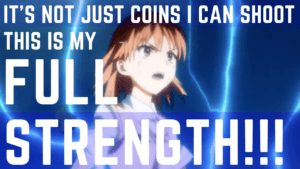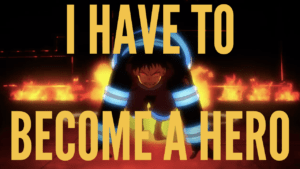Let’s learn Japanese with Takagi-san’s quote from Karakai Jouzu no Takagi-san (Skilled Teaser Takagi).
CONTENTS
Video
Takagi-san’s Quote
Japanese: やっとこっち向いた。
Romaji: yatto kocchi muita.
English: You finally looked at me.
Analysis
やっと means “finally” used when something has been achieved after a lot of time or effort.
こっち means “this way“ or “this direction”. This is one of the kosoado words which are based on the physical distance between the speaker and the listener. So こっち means “this way towards the speaker”, そっち means “that way towards the listener”, あっち means “that way away from both the speaker and the listener” and どっち means “which way” used in a question.
向いた is the ta-form or casual past tense of the verb 向く meaning “to face” or “turn towards something”. So こっち向いた directly means “faced this way” which can be translated as “looked at me”. The を particle is omitted which often happens in casual speech.
Actually, the verb 向く is a tricky word as it can take the particle に as well. But in the sentence こっちを向く, を cannot be replaced with に and here is why:
Direction を向く is used when a subjective action is carried out with the one’s own volition. こっちに向く cannot be used as the action “to face this way” is a subjective action done by someone so the particle を is used.
On the other hand, Direction に向く is used for a state where there is no subjective or volitional action. For example, その窓は北に向いている meaning “The window faces north”. In this sentence, に is used as it’s a state of the window facing north and there is no subjective action.
However, を can also be used with non-volitional action when the speaker personifies something. For example, 花は枯れて下を向いている。meaning “A flower died and it’s facing down”. In this sentence, を is used even though it’s not a subjective action as you personify the flower. So if you personify the window, you can also say その窓は北を向いている.
It’s a bit complicated but basically only を is used for a volitional action and both に and を can be used for a state of being.
Examples
やっと (finally)
1時間待って、やっと注文した料理がきた。
ichi-jikan matte yatto chūmon shita ryōri ga kita.
After waiting for an hour, the food that I ordered has finally arrived.
先週書き始めたレポートが、今日やっと終わった。
senshū kakihajimeta repōto ga, kyō yatto owatta.
The report that I started writing last week has finally finished today.
楽しみにしていたアニメがやっと始まった。
tanoshimi ni shiteita anime ga yatto hajimatta.
The anime that I’ve been looking forward to has finally started.
Difference between やっと and ついに:
- やっと – used for something you were hoping for (something good), emphasises that you waited for a long time
- ついに – used for something good or bad, emphasises that you reach a particular point at last
やっと/ついにライバルチームに勝った。
yatto/tsuini raibaru chīmu ni katta.
We finally defeated our rival team.
仕事で無理をしていたら、ついに(
やっと)倒れてしまった。shigoto de muri o shiteitara, tsuini taorete shimatta.
I was pushing myself at work, and then I finally collapsed.
こっち/そっち/あっち/どっち (Kosoado Words for Direction)
話があるから、こっちに来て座って。
hanashi ga aru kara, kocchi ni kite suwatte.
I have something to talk about, so please come and sit here.
そっちにボール投げるから、キャッチしてね!
socchi ni bōru nageru kara, kyacchi shite ne!
I’m going to throw a ball towards you so catch it!
お前なんか嫌いだ!あっちに行け!
omae nanka kirai da! acchi ni ike!
I hate you! Go away!
道が二つあるけど、どっちに進もうか。
michi ga futatsu aru kedo, docchi ni susumō ka.
There are two paths. Which way should we go?
こちら, そちら, あちら and どちら are used in polite speech.
向く (to face/turn towards something)
下を向いて歩くと危ないよ。
sita o muite aruku to abunai yo.
If you walk looking down, it’s dangerous.
着替えるから、あっち向いてて!
kigaeru kara acchi muitete!
I’m going to get changed so look the other way!
恵方巻きとは、節分に恵方を向いて食べる巻き寿司のことだよ。
ehōmaki towa, setsubun ni ehō o muite taberu makizushi no koto da yo.
Ehōmaki is a sushi roll that you eat facing the lucky direction on the day of the Setsubun (February 3rd).
向く should be used with a direction word (e.g. up, down, right, left, north, south, etc). If it’s not used with a direction word, 〜の方 should be added.
写真を撮りますよ!皆さん、カメラの方を向いてください。
shashin o torimasu yo! mina-san, kamera no hō o muite kudasai.
I’m going to take a picture! Everybody, please look towards the camera.
Difference between 向く, 向ける and 向かう:
- 向く (intransitive/transitive) – to face/turn towards something on the spot
- 向ける (transitive) – to make something face/turn towards something
- 向かう (intransitive) – to head/move towards the destination
カメラを自分の方に向けて、自撮りする。
kamera o jibun no hō ni mukete, jidori suru.
I face the camera towards myself and take a selfie.
駅に向かう途中で、先生に会った。
eki ni mukau tochū de, sensei ni atta.
On the way to the station, I met a teacher.
Support Easy Peasy Japanesey
If you enjoy our content, please consider supporting Easy Peasy Japanesey. Your support will help keep us going. Thanks for all your support!


